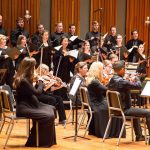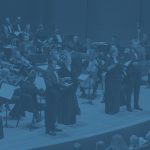Whatley Thrilled to Share the Mastery of the Organ with Audiences
“In my eyes and ears, the organ will forever be the King of Instruments.” -W.A. Mozart
Guy Whatley is to the pipe organ what Shakespeare is to the sonnet. Both have a unique ability to articulate powerful emotions through their artistry. Shakespeare achieves this through words; Whatley, by the amount of pressure he places on the organ’s manuals. “In my fingers, I control every speech of the pipes,” he explains. “I can exactly match the singers-their pitch, their tone-to perfection.”
Whatley will provide the orchestra for 20 of True Concord’s singers in concerts Feb. 26-28. Whatley says he is “thrilled” that this season features an entire program centered around the pipe organ. After sifting through thousands of pieces, he believes that the concert offers a “greatest hits for audiences.”
“We’ve got the English tradition, especially Benjamin Britten; the German Romantic tradition; France-some of the highlights of what organ art has been. I’m playing a piece of Stephen Paulus-who has become very much associated with True Concord. I’ll also be playing a Mozart piece, Fantasy in F Minor K608, which was originally written for a mechanical instrument-it’s almost impossible for a human to play, there are so many notes. It was originally called an organ piece for a clock.”
Whatley hopes audiences will come to appreciate the mastery of the pipe organ through these concerts. “It’s been on the cutting edge of so many things. Its history is intertwined with that of humankind for more than 2,000 years.”
To prepare for the concerts, Whatley says he must spend hours in advance working with each organ, registering it specifically for the venue attributes. “When you play the organ, you play the room,” he explains. “The acoustics of the room, the placement of the instrument itself, the positioning of the choir will all dictate the manuals and the amount of pressure I apply to the keys must be considered.”
Whatley adds that the rehearsal time with the singers is where his work with the organ and their contributions vocally is so important to making it all perfect-and it’s where they get to have a good time creatively. “We use the rehearsals to come together in unanimity,” he says. “My effortless way of playing the music is exactly like their effortless way of singing it. It’s very creative and fun-if we make different decisions then it becomes a different piece of music.”
Whatley says it’s amazing when a community recognizes the importance of having an organ and having two recently installed in southern Arizona demonstrates an appreciation for the beauty of the instrument. “The organ is one of the most amazing creations of humanity, and if we study the organ through its vast history, we learn so much about the different cultures. Everything goes into them-their knowledge about science and art-it all has to come together in one instrument.”
About the four organs:
- The organ at Green Valley’s Lutheran Church of the Risen Savior was built by Holtkamp Organ Company, Op. 2112, with three manuals (keyboards), 28 stops, 33 ranks, and 1945 pipes. The installation began on Sept. 29, 2015 and the completed organ was dedicated on Jan. 10, 2016.
- Philip’s in the Hills’s organ was built as part of the 50th anniversary expansion of the church in 1986. The large three-manual pipe organ was created by the Holtkamp Organ Company, and later expanded in 2005
- Catalina United Methodist Church debuted its new organ on Easter 2015. The Quimby Opus 70 is a four- manual 57 rank organ with more than 3000 pipes It is the only area pipe organ with four manuals.
- Alban’s dedicated its Paul Fritts Op. 35 in July 2012. The organ has two manuals, 22 stops, with over 1100 pipes. The visually striking instrument is modeled after European Baroque organs, although it is well suited for 19th and 20th century music as well.





